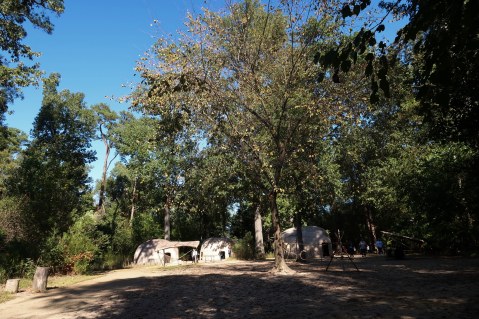
Powhatan Village at Jamestown Settlement
When the English arrived in what’s now Virginia, native peoples had been living on the coastal plain of Virginia for thousands of years. Sometimes known as Algonquians, because of the Algonquian language they spoke and because of their common culture, approximately 32 tribes were ruled over by a chieftain known as Wahunsonacock. The English would call him “Powhatan” and the people he ruled the “Powhatans.” Each tribe had their own chief, “werowance” (male) or “werowansquas” (female). While each tribe lived in separate villages they shared religious beliefs and cultural traditions.
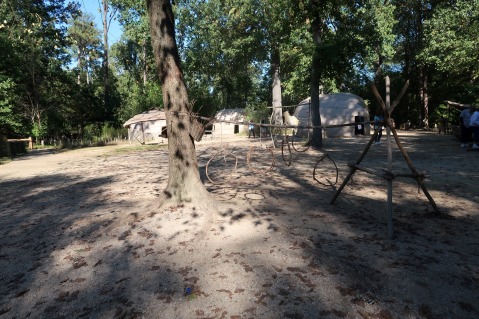
Powhatan Village
The Powhatan Indians called their land Tsenacommacoh. The seat of power was known as Werowocomoco. Werowocomoco was situated on an ancient ceremonial site and was the center of Powhatan’s chiefdom. Before the English arrived, he had increased his dominion from six inherited tribes to more than 30 tribes.
Everyone paid tribute taxes of deerskins, shell beads, copper, or corn to the local ruler. In turn, the local chiefs paid tribute to Powhatan. They received Powahatan’s protection in exchange for their tributes. In Powhatan culture, kinship and inheritance pass through the female line.
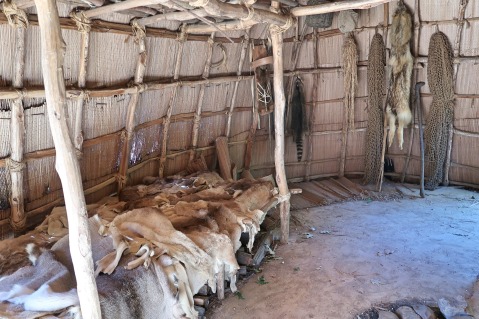
Animal skins for tribute inside a yehakin
Powhatan villages were located along the banks of larger rivers or major tributaries. The nearest Powhatan tribe to Jamestown was the Paspahegh. The Paspahegh had towns upriver from Jamestown situated along both sides of the Chickahominy River. With at least 200 people, the Paspahegh was one of the core tribes of the Powhatan chiefdom. Most Powhatan settlements were much smaller, with less than 100 people.
Ten to twenty houses, known as yehakins, were randomly situated among shade trees and fields. Yehakins were made from natural materials found in the surrounding environment. The yehakin framework was made from saplings of local trees like red maples, locusts and red cedar. Bark shingles stripped from trees or marsh reed mats covered the framework. The mats could be rolled up in summertime. Yehakins could be small and round or oblong with rounded ends to make them more wind resistant.
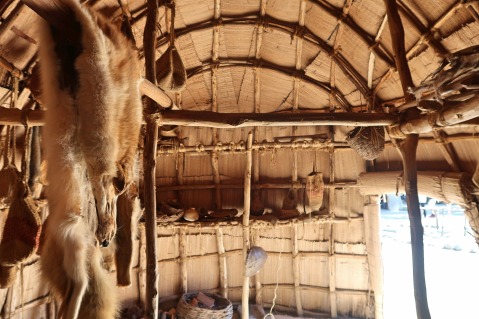
Inside a yehakin
Most yeahakins contained only a single room. Furniture consisted of fur or mat-covered sleeping benches built along the walls. Drying lofts were built above the sleeping benches. More beds of deerskin or reed mats could be laid on the ground. A fire in the center of the room was the main source of light and heat. In the roof, a small smoke hole cut directly over the fire provided ventilation. The smoke hole and doors allowed additional light to come through. Houses were mostly used for sleeping and storage because they were poorly lit. The visitor gets an impression of a cozy space filled with the pleasant scent of woodsmoke. I know from visiting Plimoth Plantation that on a cool, damp day, this is where everyone wants to be. I’m not sure I’d like to live there with a bunch of other people but I know different cultures and times have different ideas of privacy.

Powhatan houses were located near the planting fields. This allowed the which was Powhatans move when their fields were no longer fertile. Their lifestyle followed a seasonal cycle with planting, hunting, fishing and gathering following the rhythm of the seasons. They raised varieties of corn, beans and squash (like pumpkins). Corn was the most important. It could be ground and made it into flat cakes or boiled in stews with beans, squash and wild game or fish.
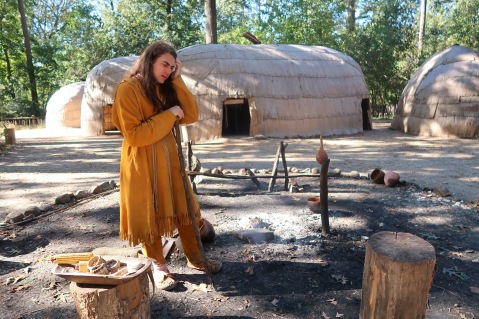
Cooking demonstration
Half their food was obtained through farming in the summer. Women and children planted corn and bean crops in small mounds, placing squash and gourds in-between. Corn, beans and squash could be dried and preserved for later use throughout the year. Dried gourds were used as musical instruments and for bowls, cups, and scoops. In late winter and spring, they gathered fruit, nuts, grain, tubers, and roots to supplement their diet.

native foods
While women farmed, men hunted. Hunting was the chief occupation of Powhatan men. Powhatan men hunted large game with bows and arrows and captured small animals with traps or snares. The native animals provided the Powhatan with many needed resources and materials such as clothing, food, and tools. It is believed hunting was done mainly in the winter months when brush was sparse and fishing was done mostly in the spring and early summer. The men caught freshwater fish, ocean fish, and shellfish, often trapping fish in weirs stretched across waterways.
Men made tools and weapons from wood, bone, shell, and stone. They made axes, mortars, and pestles by grinding and polishing stone. They could also make arrow points and tools for cutting and scraping striking one stone with another harder stone in an effort to reduce the softer stone bit-by-bit. Men wove fish nets and fish traps from plant fibers.
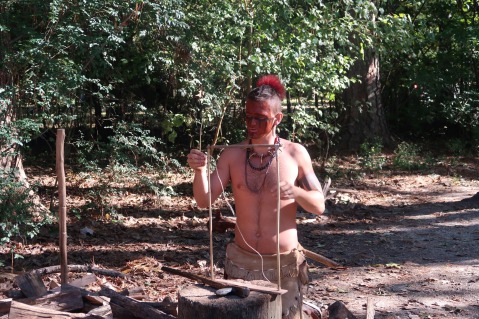
Setting up a loom for weaving
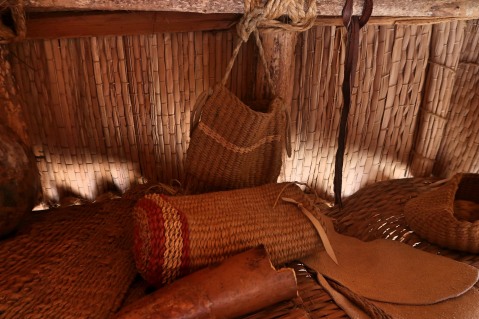
woven baskets

woven basket
Powhatan women used local clay to make pottery vessels for cooking and storage, produced clothing from deer hides and wove mats out of reeds to cover houses. Women tanned the hides and used bone awls, bone needles and deer sinew to fasten their garments together. Clothing could be decorated with fringe, beads, bones, teeth or painted designs.

Skin ready for tanning
As you can see above, Powhatan men and women painted their faces. They used a mixture of red paint and nut oil for paint and used bear fat to ward off winter cold and summer insects. Women’s bodies were tattooed with abstract designs or pictures of flowers, fruits, snakes and lizards. The elite wore beaded necklaces, bracelets and earrings- status symbols at the time. The more common folk made jewelry from shell beads, freshwater pearls, copper and animal teeth or bones. 17th-century Powhatan men and women commonly wore an apron of deerskin around the waist. Men wore fur cloaks, loose sleeves and leggings. For trips to the forest, they wore Moccasins.
Children worked as well, diving their work by gender working alongside their parents. Children could also be used as runners, as the Powhatan did not have horses at this time. Young children may also have been used as scarecrows, sitting in small houses in the middle of their corn fields.
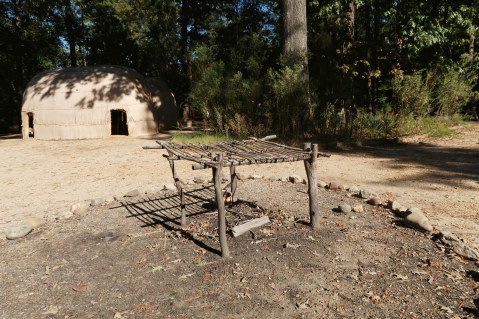
Powhatan village
The Powhatan participated in an expansive trading network of luxury goods. The elite used this type of trading as a means to increase social status. Indians who lived upriver could trade freshwater pearls for ornaments made from large marine shells collected by eastern people. The Powhatans also traded for scarce metals like copper from groups outside the chiefdom. They traded for puccoon, a red dye used to make a highly valued paint with those to the south. When the English arrived, the Powhatan saw a chance for expanded trade opportunities.
After several confrontations
Werowocomoco was abandoned in 1609 after Powhatan became wary of the Englisg and Powhatan moved to another location further away from Jamestown. Virginia Indians may have continued to live there for a time. The English took over the land by the 1630s, patenting extensive farms.
More on what happened to the Powhatan and Virginia Indians after the 17th century in another post.
The village is interesting because it’s interactive and you can experience Powhatan life. I didn’t ask any questions or engage in conversation. The indoor museum was very thorough but the interpreters are happy to explain and answer questions.
“Who Were the Powhatan Indians and How Did They Live?”, https://www.historyisfun.org/learn/learning-center/who-were-the-powhatan-indians-and-how-did-they-live-2/
“Wereowocomoco,” https://www.historyisfun.org/learn/learning-center/werowocomoco/
“Where Was the Closest Powhatan-Tribe to Jamestown?”, https://www.historyisfun.org/learn/learning-center/where-was-the-closest-powhatan-tribe-to-jamestown/
“What were Powhatan homes like?”, https://www.historyisfun.org/learn/learning-center/what-were-powhatan-homes-like/
“Featured Video for Educators, How to Eat Like a Powhatan”, https://www.historyisfun.org/video/eat-like-a-powhatan/